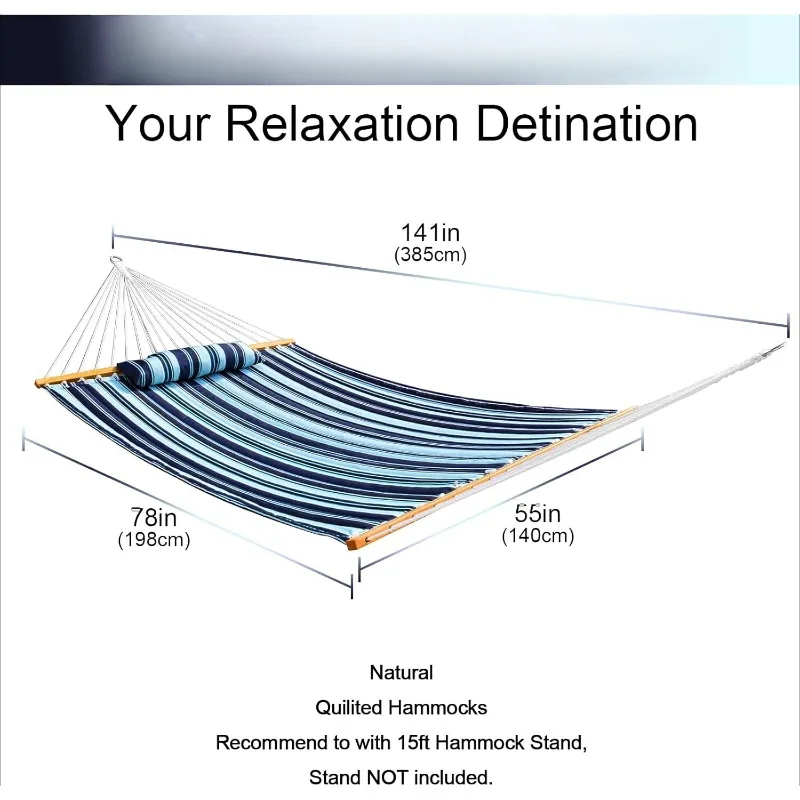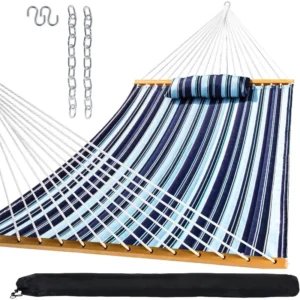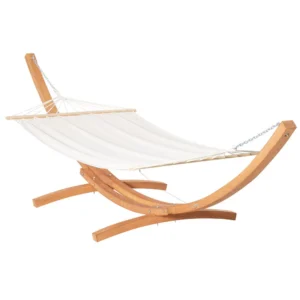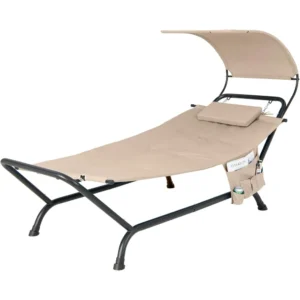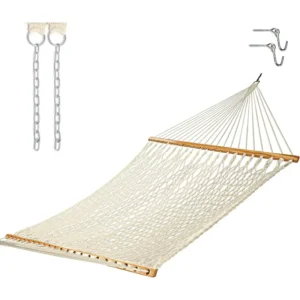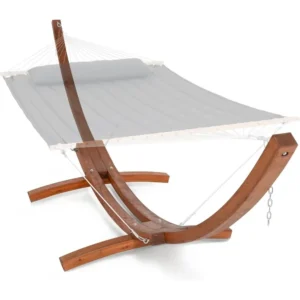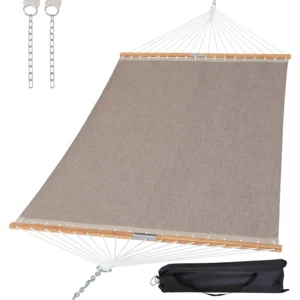Introduction: Why Quilted Hammocks Offer the Ultimate Relaxation Experience
Imagine sinking into a cloud-like cradle, feeling the gentle sway as your body melts into plush, supportive padding. The sun filters through nearby trees while you drift between wakefulness and dreams, perfectly suspended in comfort. This is the quilted hammock experience – the pinnacle of outdoor relaxation.
Unlike their rope or traditional fabric counterparts, quilted hammocks represent the luxury sedan of the hammock world. With their substantial padding, stable design, and weather-resistant materials, they transform ordinary outdoor moments into extraordinary relaxation experiences. The layered construction distributes your weight evenly, eliminating pressure points while providing insulation from both heat and cold.
This comprehensive guide will help you navigate the world of quilted hammocks to find your perfect match. We’ll explore the critical elements that contribute to exceptional comfort – from padding materials to fabric selection, structural design to size considerations. You’ll discover how proper hammock placement for maximum comfort affects your relaxation experience and learn which models deliver the best combination of luxury and durability.
The growing trend toward creating dedicated outdoor relaxation spaces has fueled innovation in quilted hammock design, offering more choices than ever before. By understanding what makes these hammocks so special, you’ll be equipped to select the perfect addition to your relaxation arsenal. The unmatched comfort of quilted hammocks awaits your discovery.
What Makes Quilted Hammocks So Exceptionally Comfortable?
Quilted hammocks stand apart from other hammock styles thanks to their unique combination of structural elements specifically engineered for comfort. Unlike rope hammocks with their open weave or Brazilian hammocks with their single layer of fabric, quilted hammocks feature multiple layers of material sandwiching soft padding to create a luxurious resting surface.
The exceptional comfort of a quality quilted hammock comes from several key components working together:
Supportive Foundation: The quilted design creates a stable, cushioned surface that contours to your body without excessive sagging or pressure points.
Premium Materials: High-quality fabrics paired with substantial padding create the plush feel that makes these hammocks so inviting.
Structural Stability: Many quilted hammocks incorporate spreader bars that maintain a flatter, more bed-like surface that’s easier to enter and exit while providing better body alignment.
Weather Adaptability: The padding layer provides insulation against both heat and cold, making these hammocks comfortable across seasons.
The science behind quilted hammock comfort involves proper weight distribution and ergonomic support. When you lie in a well-designed quilted hammock, your body weight spreads evenly across the padded surface, allowing muscles to fully relax. This differs dramatically from the experience of quilted versus non-quilted hammocks, where the latter may create pressure points or uncomfortable bunching.
Each element of a quilted hammock’s construction plays a vital role in the overall comfort experience, from the softness of fabrics against your skin to the stability provided by the suspension system. Let’s examine these components in detail to understand what truly makes for an exceptional relaxation experience.
The Anatomy of Comfort: Plush Padding and Premium Fill Materials
The heart of a quilted hammock’s comfort lies in its padding. This layer transforms what would otherwise be a simple fabric sling into a cloud-like resting place that provides both cushioning and support.
The most comfortable quilted hammocks use these fill materials:
Polyester Fiberfill: The most common padding material, offering excellent loft, durability, and moisture resistance. Quality models use high-grade polyester with finer fibers for a softer feel, typically in the 4-8 ounce per square yard range.
Cotton Batting: Provides a natural, breathable padding option with exceptional softness. However, it absorbs moisture more readily than synthetic alternatives, making it better suited for covered areas or indoor use.
Blended Fills: Some premium models combine materials to balance comfort, durability, and weather resistance. These might include polyester cores with cotton outer layers for optimal skin contact comfort.
Memory Foam Inserts: High-end quilted hammocks sometimes incorporate memory foam panels in strategic areas to enhance support for the neck, lower back, or shoulders.
The thickness and density of the padding directly impact your comfort experience. Too thin, and you’ll feel every wrinkle in the underlying fabric; too thick, and the hammock may feel unstable. The ideal padding thickness typically ranges from 1 to 2 inches when compressed, providing sufficient cushioning without compromising stability.
Equally important is how the padding is distributed. Quality quilted hammocks feature consistent fill across the entire surface, with additional reinforcement in high-pressure areas like the center. The best fabric types for quilted hammocks work in harmony with this padding to create the ultimate comfort system.
The quilting pattern itself serves a crucial function beyond aesthetics – it keeps the fill material evenly distributed over time. Diamond, channel, and box stitch patterns each offer different comfort characteristics, with smaller quilting sections generally providing more stable padding that resists shifting and clumping through extended use.
Fabric Quality and Construction: The Surface-Level Comfort Factor
While padding creates the foundation of comfort, the fabric that envelops your body determines much of your immediate sensory experience. The best quilted hammocks pair plush padding with fabrics that feel wonderful against your skin while standing up to environmental challenges.
| Fabric Type | Feel Against Skin | Durability | Weather Resistance |
|---|---|---|---|
| Sunbrella | Soft but sturdy | Excellent | Superior |
| DuraCord | Very soft | Excellent | Excellent |
| Olefin | Smooth and cool | Very Good | Very Good |
| Cotton Blend | Softest | Good | Moderate |
The weave and thread count of the fabric significantly impact comfort. Tighter weaves with higher thread counts generally offer a smoother, more luxurious feel, though they may sacrifice some breathability. The ideal balance depends on your climate and sensitivity preferences.
Solution-dyed acrylic fabrics like Sunbrella maintain their soft feel significantly longer than printed fabrics because the color permeates the entire fiber rather than sitting on the surface. This means they won’t become rough or stiff with sun exposure over time – a crucial consideration for long-term comfort.
Quilting patterns do more than secure the padding – they influence how the hammock conforms to your body. Deeper, more pronounced quilting creates distinct cushioned sections that cradle your body, while more subtle quilting provides a smoother, more uniform surface. The fabric characteristics that improve outdoor comfort extend beyond mere softness to include breathability, moisture-wicking capabilities, and temperature regulation.
The stitching itself deserves attention, as double or reinforced stitching not only extends durability but prevents uncomfortable ridges or seams from developing over time. Premium models often feature hidden or flat seam construction specifically to eliminate potential pressure points.
Structural Support: Spreader Bars, Suspension Systems, and Stability
The structural elements of a quilted hammock play a crucial role in translating padding and fabric quality into actual relaxation comfort. Most quilted hammocks incorporate spreader bars – horizontal rods at each end that keep the hammock open and flat rather than allowing it to close around you like a traditional hammock.
These spreader bars deliver several comfort advantages:
- They create a flatter, more bed-like surface that’s easier to get into and out of
- They prevent the “cocoon effect” that can feel claustrophobic to some users
- They allow for diagonal lying positions that many find more comfortable for the back
The material of these spreader bars affects both comfort and durability. Hardwood options like oak, cypress, or cumaru provide classic aesthetics with natural flexibility that absorbs small movements. Metal spreader bars (typically aluminum) offer superior weather resistance and often support higher weight capacities without flexing, providing a more stable platform.
The ideal spreader bar width typically matches or slightly exceeds the hammock’s fabric width, creating a fully extended surface without pinching at the edges. This design characteristic is common in many spreader bar hammock sets and contributes significantly to overall comfort.
Beyond the spreader bars, the suspension system – how the hammock connects to its support structure – influences stability and comfort. Chain or rope suspensions with multiple connection points distribute weight more evenly and reduce excessive swaying. The angle of suspension also matters; a shallower angle (30-35 degrees from horizontal) typically provides more stable support than steeper angles.
The best quilted hammocks combine these structural elements harmoniously, creating a platform that feels secure and supportive while still allowing for the gentle rocking motion that makes hammock relaxation so uniquely soothing.
Finding Your Perfect Fit: Size, Dimensions, and Capacity
When it comes to quilted hammocks, size significantly impacts comfort. Contrary to what intuition might suggest, larger is often better – even for solo users. This explains why many people find “double” sized quilted hammocks provide superior comfort even when used by just one person.
The ideal width for a single-person quilted hammock typically ranges from 48 to 54 inches. For shared use or those who prefer more space, double two-person hammock sets generally measure between 54 and 60 inches wide. This extra width allows for comfortable diagonal positioning – the optimal way to lie in a hammock for proper back alignment and maximum comfort.
Length considerations are equally important, especially for taller individuals. Most quality quilted hammocks range from 78 to 85 inches in bed length, with the total length (including suspension points) extending to 13 feet or more. As a general guideline, your hammock bed should be at least 2 feet longer than your height for optimal comfort.
Weight capacity directly correlates with comfort and durability. A hammock stressed near its weight limit will feel less stable and wear out faster. For single users, look for capacities of at least 300-400 pounds; for couples or heavier individuals, 450-600 pound capacities provide better long-term comfort.
The relationship between hammock size and hanging distance also warrants consideration. Larger hammocks typically require more installation space – about 2 feet more than the hammock’s total length to achieve the ideal hanging tension. This spatial requirement impacts both comfort and safety, as a properly tensioned hammock provides optimal support without excessive sagging or dangerous tightness.
Top 7 Most Comfortable Quilted Hammocks Worth Considering
After extensive research and evaluation of dozens of quilted hammocks, we’ve identified seven standout options that deliver exceptional comfort along with durability and value. Our selection process considered multiple factors: padding quality and distribution, fabric softness and durability, structural support, size appropriateness, and verified user experiences.
Each recommendation excels in different aspects of comfort, allowing you to match features to your specific priorities. We’ve assessed these hammocks based on their immediate comfort impression as well as how they maintain that comfort through extended use and exposure to elements.
In the following sections, we’ll provide detailed reviews of each hammock, highlighting its unique comfort features, ideal usage scenarios, and any limitations to consider. Whether you prioritize plush padding, weather resistance, supportive design, or overall luxury experience, our curated selection of quilted fabric hammock sets has options to meet your needs.
These reviews aim to go beyond marketing claims to provide honest assessments of what each hammock truly delivers in terms of comfort experience. Use these insights to narrow your options to the hammock that best matches your relaxation style, installation location, and comfort preferences.
1. [Premium Comfort Pick] Quilted Hammock
This premium quilted hammock represents the gold standard for outdoor relaxation comfort, featuring an exceptional combination of padding thickness, fabric quality, and structural support.
The standout comfort feature is its dual-layer padding system with 1.5 inches of high-loft polyester fiberfill quilted in a diamond pattern that prevents shifting while contouring perfectly to your body. This creates an almost mattress-like surface that eliminates pressure points completely.
The outer fabric uses 600-denier solution-dyed acrylic with a remarkably soft finish that feels luxurious against bare skin while providing industry-leading UV and weather resistance. The spreader bars use kiln-dried hardwood with a subtle curve that creates an ergonomic lounging surface rather than a completely flat plane.
Pros:
– Exceptional padding thickness and distribution
– Ultra-soft fabric with superior weather resistance
– Curved spreader bars for improved ergonomics
– Reinforced stitching for long-term comfort maintenance
– Includes integrated neck pillow
Cons:
– Premium price point
– Heavier than simpler quilted models
– Requires careful cleaning to maintain padding loft
Specifications:
– Dimensions: 55” × 84” bed size
– Weight capacity: 500 lbs
– Materials: Solution-dyed acrylic fabric, polyester fiberfill
– Spreader bars: Curved hardwood
– Suspension: Stainless steel chains with quick-connect links
This hammock is ideal for those who prioritize comfort above all else and are willing to invest in a premium relaxation experience.
2. [Best Weather-Resistant Comfort] Quilted Hammock
This remarkable quilted hammock stands apart through its ability to maintain exceptional comfort in challenging weather conditions. While many quilted hammocks sacrifice comfort for durability, this model achieves both.
The secret lies in its specialized Olefin fabric exterior that repels water while remaining surprisingly soft to the touch. The padding utilizes quick-drying polyester with antimicrobial treatment to prevent mold and mildew – crucial for maintaining comfort in humid environments.
Most impressive is the hammock’s ability to dry quickly after rain, with specially designed drainage channels built into the quilting pattern. The fill material resists clumping even after repeated wetting and drying cycles, ensuring consistent comfort throughout the seasons.
Pros:
– Superior weather resistance without sacrificing softness
– Quick-drying technology prevents soggy discomfort
– Fade-resistant fabric maintains comfort appearance
– Antimicrobial treatment prevents odors
– Four-season comfort capability
Cons:
– Slightly less plush than indoor-focused models
– Limited color options compared to less weather-resistant alternatives
– Requires occasional water-repellent reapplication for optimal performance
Specifications:
– Dimensions: 52” × 80” bed size
– Weight capacity: 450 lbs
– Materials: Solution-dyed Olefin fabric, quick-dry polyester fill
– Spreader bars: Powder-coated aluminum
– Water resistance rating: 4/5
This hammock is perfect for users in variable climates who don’t want to sacrifice comfort when the weather turns unpredictable.
3. [Best Value Comfort] Quilted Hammock
This intelligently designed quilted hammock delivers remarkable comfort at a more accessible price point, proving that exceptional relaxation doesn’t require a premium budget.
The hammock achieves its impressive comfort-to-cost ratio by focusing on what matters most: strategic padding distribution. Rather than uniform thickness throughout, this model concentrates the densest padding in the center third where body weight typically concentrates. The quilting pattern uses smaller sections in high-pressure areas and larger sections elsewhere, maximizing comfort where needed while economizing elsewhere.
The polyester-cotton blend fabric offers surprising softness comparable to much more expensive models, though it may require more frequent cleaning and protection from extended weather exposure.
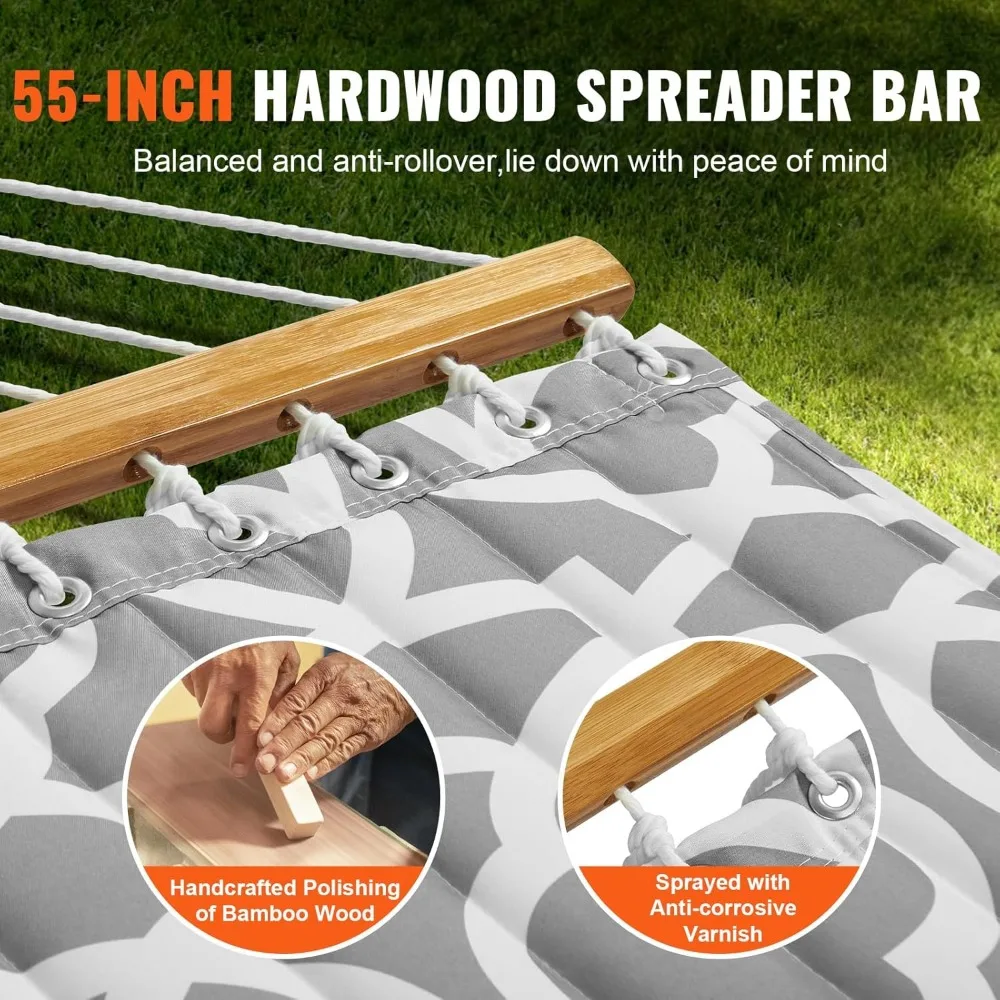
Pros:
– Exceptional comfort for the price point
– Smart padding distribution prioritizes comfort where needed
– Soft fabric blend feels great against skin
– Reinforced center section resists sagging
– Includes basic but functional hanging hardware
Cons:
– Less weather-resistant than premium models
– May require replacement after 2-3 seasons of heavy use
– Limited warranty compared to higher-priced options
Specifications:
– Dimensions: 54” × 78” bed size
– Weight capacity: 400 lbs
– Materials: Polyester-cotton blend fabric, polyester fiberfill
– Spreader bars: Treated pine
– Price-to-comfort ratio: 5/5
For comfort-conscious shoppers working within budget constraints, this fabric hammock delivers remarkable value without significant comfort compromises.
Classic Wooden Stand Hammock Sets, Heavy Duty Hammock Sets
$1,061.68 Select options This product has multiple variants. The options may be chosen on the product pageHammock Sets with Canopy, Heavy Duty Hammock Sets
$286.31 Select options This product has multiple variants. The options may be chosen on the product pageDouble / Two Person Hammock Sets, Rope Hammock Sets
Double Traditional Cotton Rope Hammock with Extension Chains – 450 lbs Capacity for Backyard & Patio$292.98 Select options This product has multiple variants. The options may be chosen on the product pageHeavy Duty Hammock Sets, Wooden Arc Stand Hammock Sets
$878.66 Select options This product has multiple variants. The options may be chosen on the product page
4. [Most Supportive Design] Quilted Hammock
This engineering-focused quilted hammock prioritizes ergonomic support above all other comfort factors, making it ideal for those with back concerns or who plan extended lounging sessions.
The standout feature is its three-zone support system – the hammock incorporates varying padding densities across its length, providing firmer support for the lower back region while using softer padding for shoulders and legs. This thoughtful design helps maintain proper spinal alignment during extended use.
The quilting pattern itself contributes to the supportive design, using a distinctive channel pattern that creates gentle contours that cradle the body. The spreader bars feature a slight arc rather than remaining perfectly straight, creating a subtle hammock curvature that better accommodates the natural human form.
Pros:
– Superior ergonomic support for back and neck
– Zone-specific padding densities
– Supportive yet comfortable for hours of use
– Reduces pressure points better than flat designs
– Excellent for reading or working in a reclined position
Cons:
– Firm support may feel less plush initially
– Takes longer to “break in” to maximum comfort
– Slightly narrower than comparable models
Specifications:
– Dimensions: 48” × 82” bed size
– Weight capacity: 425 lbs
– Materials: Structured polyester fabric, multi-density foam padding
– Spreader bars: Contoured hardwood
– Support rating: 5/5
This hammock is perfect for those who need therapeutic-level support without sacrificing the relaxation benefits of hammock lounging.
5. [Best Luxury Comfort Experience] Quilted Hammock
This exceptional quilted hammock epitomizes luxury relaxation through meticulous material selection and craftsmanship details that create a truly elevated comfort experience.
The fabric alone sets this model apart – using a 600-thread count cotton-Sunbrella blend that feels like premium bedding against the skin while maintaining outdoor durability. The padding combines traditional polyester fill with gel-infused memory foam inserts in the central region, creating a pressure-relieving cradle that adapts to your body’s unique contours.
Attention to detail extends to the integrated pillow system with adjustable loft, allowing personalized head and neck support. Even the spreader bars receive special treatment with hand-finished hardwood that’s both beautiful and ergonomically shaped.
Pros:
– Hotel-quality comfort in an outdoor hammock
– Pressure-relieving memory foam sections
– Ultra-soft fabric with luxury-level thread count
– Adjustable integrated pillow system
– Handcrafted finishing touches
Cons:
– Requires more careful maintenance
– Premium price point
– May be too plush for those who prefer firmer support
Specifications:
– Dimensions: 58” × 85” bed size
– Weight capacity: 475 lbs
– Materials: Cotton-Sunbrella blend fabric, hybrid foam/fiber fill
– Spreader bars: Hand-finished teak
– Luxury features: Integrated adjustable pillow, decorative tassels, matching storage bag
For those seeking a truly indulgent relaxation experience, this hammock delivers uncompromising comfort with sophisticated styling.
6. [Most Durable Comfort] Quilted Hammock
This impressively engineered quilted hammock stands out for its ability to maintain consistent comfort through years of use and exposure, making it an excellent long-term investment for serious relaxation enthusiasts.
The comfort longevity begins with construction methods typically found in high-end furniture rather than outdoor accessories. The quilting uses marine-grade thread in a double-lock pattern that prevents fill migration even after years of use. The padding itself uses compression-resistant polyester specifically formulated to retain its loft despite regular weight-bearing.
The fabric employs solution-dyed acrylic with additional protective treatments that maintain softness through countless weather cycles. Even the hardware elements feature overbuilt design, with reinforced mounting points that prevent the fabric stretching and deformation that can compromise comfort over time.
Pros:
– Maintains consistent comfort for 5+ years
– Compression-resistant padding retains loft
– Fabric stays soft despite weather exposure
– Industrial-grade construction prevents sagging
– Industry-leading warranty coverage
Cons:
– Heavier than less durable alternatives
– Higher initial investment
– Less padding “give” when new (improves with use)
Specifications:
– Dimensions: 52” × 80” bed size
– Weight capacity: 550 lbs
– Materials: Marine-grade solution-dyed acrylic, compression-resistant polyester fill
– Spreader bars: Powder-coated aluminum
– Warranty: 5-year comprehensive coverage
This model is ideal for those who view their hammock as a long-term investment and prioritize consistent comfort performance over time. Many heavy-duty hammock sets incorporate similar construction principles.
7. [Most Versatile Comfort] Quilted Hammock
This adaptable quilted hammock excels by providing comfortable experiences across different users, settings, and relaxation styles – making it perfect for households with varying preferences or those who enjoy changing their setup seasonally.
The hammock’s versatility stems from its reversible design, offering different comfort experiences on each side. One surface features plush quilting optimized for cooler weather, while the reverse side uses a more breathable pattern ideal for warmer conditions. The fill material itself responds to body temperature, providing more cushioning as it warms.
The hammock’s proportions accommodate both traditional and diagonal lying positions comfortably, while the spreader bar design allows for adjustable tensioning to create either a flatter or more cradled experience based on preference.
Pros:
– Reversible design for seasonal comfort optimization
– Accommodates multiple lounging positions
– Works well for users of varying heights and weights
– Adaptable to different hanging configurations
– Suitable for both indoor and outdoor use
Cons:
– Jack-of-all-trades approach means it’s not specialized for any one use case
– Requires some experimentation to find optimal setup
– Middle-range pricing despite lacking premium materials
Specifications:
– Dimensions: 55” × 82” bed size
– Weight capacity: 450 lbs
– Materials: Polyester-blend fabric with dual texture, temperature-responsive fill
– Spreader bars: Composite with multiple attachment points
– Versatility rating: 5/5
This hammock is perfect for households with multiple users or those who want a single hammock that can adapt to different settings and seasons.
Buyer’s Guide: Finding Your Perfect Quilted Hammock for Maximum Comfort
Selecting the ideal quilted hammock requires understanding your personal comfort preferences and how you plan to use your hammock. Consider these key factors to guide your decision:
Primary Usage Pattern
How you intend to use your hammock significantly impacts which comfort features matter most. For occasional afternoon napping, a middle-range padding thickness may suffice. For regular reading or working sessions, prioritize ergonomic support and stability. For overnight sleeping, look for models with enhanced padding and body-contouring designs.
Body Type Considerations
Your height, weight, and sleeping preferences should influence your hammock selection. Taller individuals need longer hammock beds to prevent uncomfortable foot dangling. Heavier users should prioritize models with reinforced stitching, higher weight capacities, and compression-resistant padding. Side-sleepers typically need softer, more adaptive padding than back-sleepers.
Climate Adaptability
Your local weather patterns should guide fabric and filling choices. Hot, humid environments demand breathable fabrics and moisture-wicking capabilities. Cooler climates benefit from denser padding with better insulation properties. For variable weather, consider heavy-duty hammock solutions with weather-resistant features or reversible designs.
Installation Location
Where you’ll hang your hammock affects comfort requirements. Fully exposed outdoor locations demand superior weather resistance that might compromise some softness. Covered patios allow for softer fabrics with less weather protection. Indoor use opens possibilities for ultra-plush options that wouldn’t survive outdoors.
Comfort Investment Timeline
Consider how long you expect your hammock to maintain its comfort. Budget-friendly options might provide excellent initial comfort that diminishes after a season or two. Premium models with higher price points typically maintain consistent comfort for many years, offering better long-term value despite higher upfront costs.
By understanding these factors, you can prioritize the features that will deliver your ideal personal comfort experience rather than being swayed by marketing claims or generic recommendations.
Material Considerations: Choosing Fabrics and Fills for Your Comfort Style
The materials used in your quilted hammock dramatically impact both how it feels and how long that comfort lasts. Understanding these material options helps you make choices aligned with your comfort priorities.
Exterior Fabric Options
Sunbrella/Solution-Dyed Acrylic: Offers the best balance of softness and weather resistance. The color permeates the entire fiber, preventing fading and fabric hardening. Ideal for permanent outdoor installations where comfort must withstand the elements.
Olefin: Provides excellent moisture resistance and quick-drying properties with good softness. Not quite as soft as premium acrylics but offers superior performance in wet environments.
Cotton and Cotton Blends: Delivers the softest initial feel against skin but requires more protection from elements. Best for covered areas or seasonal use where maximum tactile comfort is prioritized over durability.
Polyester Blends: Offers good balance of affordability and performance. Less soft than cotton but more durable, with mid-range weather resistance.
Fill Materials and Their Comfort Characteristics
Standard Polyester Fiberfill: The most common option, providing good loft and moderate support. Recovers well from compression but may flatten in high-pressure areas over time.
High-Memory Polyester: Premium version that maintains shape better and provides more consistent support throughout the hammock’s life.
Cotton Batting: Creates a softer, more natural feel but absorbs moisture and compresses more permanently over time. Works best in protected environments.
Foam Inserts: Provides structured support and pressure relief, especially when combined with fiber fill. Creates a more bed-like experience.
Understanding how quilting designs affect hammock comfort helps you select the pattern that best suits your relaxation style. Smaller, more numerous quilting sections generally provide more stable padding that resists shifting but may create more noticeable seams. Wider quilting creates a smoother surface but allows more fill migration over time.
For maintenance considerations, synthetic materials generally retain their comfort properties longer with less care, while natural materials offer superior initial comfort but require more protection and maintenance to preserve their feel.
Essential Accessories to Enhance Your Quilted Hammock Comfort
The right accessories can transform a good hammock experience into an exceptional one by addressing specific comfort needs or limitations.
Supportive Stands
A quality hammock stand provides stable, reliable support that enhances comfort by eliminating swaying or sagging. Wooden arc stand hammock sets offer particularly elegant support with their curved design that creates an optimal hanging angle without requiring trees or posts. Metal stands typically allow more adjustability but may provide less aesthetic appeal.
Comfort-Enhancing Pillows
Specialized hammock pillows contoured to accommodate the natural hammock curve can dramatically improve neck and head comfort. Look for weather-resistant options with similar fabric to your hammock for the best match in both comfort and durability.
Protective Canopies and Covers
Canopies protect both you and your hammock from sun exposure, extending comfort during bright days while preserving fabric softness long-term. Storage covers protect your hammock when not in use, preventing unnecessary weather exposure that can degrade comfort features.

Stability Enhancements
Spring links or rubber dampeners can reduce excessive swinging, creating a more stable relaxation platform preferred by many readers or those prone to motion sensitivity. These small additions dramatically change the comfort dynamics, especially in windier locations.
Convenience Additions
Side pockets, cup holders, and book stands may seem like mere conveniences, but they significantly enhance comfort by eliminating the need to get up frequently or maintain awkward positions to hold items. This allows for longer, more relaxed hammock sessions without interruption.
When selecting accessories, prioritize those that address your specific comfort challenges. If you find your neck strained, a specialized pillow offers more value than a canopy. If stability concerns prevent full relaxation, focus on suspension enhancements before considering convenience additions.
Maintaining Your Quilted Hammock for Long-Lasting Comfort
Proper maintenance preserves both the aesthetic appeal and comfort characteristics of your quilted hammock, extending its life and protecting your investment.
Cleaning for Comfort Preservation
• Brush off loose dirt and debris weekly to prevent it from embedding in fabric
• Spot clean spills immediately with mild soap and water, avoiding harsh chemicals
• For deeper cleaning, use fabric-appropriate cleaners that won’t degrade weather resistance
• Allow hammock to dry completely before folding or storing to prevent mildew that can degrade padding
Storage Techniques to Maintain Padding Loft
• Never compress your hammock for long-term storage
• Store loosely folded or rolled rather than tightly bundled
• Use a breathable storage bag that protects from dust without trapping moisture
• Store indoors or in weather-protected areas during off-seasons
Seasonal Care Recommendations
• Before seasonal storage, clean thoroughly and ensure complete drying
• Check and tighten all hardware and connection points at the beginning of each season
• Apply fabric protectant to maintain water and stain resistance annually
• Flip reversible hammocks regularly to ensure even wear on both sides
Repair Strategies for Comfort Issues
• Address small tears or holes immediately before they expand
• Re-fluff compressed padding areas by gently massaging and separating fibers
• Replace damaged hardware promptly to prevent stress on fabric sections
• Consider professional re-stuffing for older hammocks with compressed padding
Understanding whether you should leave your hammock outside in your specific climate conditions can dramatically impact how long its comfort features last. As a general rule, even weather-resistant hammocks benefit from being brought in during severe weather or extended periods of non-use.
Following these maintenance practices ensures your quilted hammock remains as comfortable in year three as it was on day one.
Indoor vs. Outdoor Use: Optimizing Your Quilted Hammock’s Comfort
Quilted hammocks can excel in both indoor and outdoor environments, but each setting presents different comfort considerations and optimization opportunities.
For outdoor installation, weather exposure significantly impacts comfort longevity. Direct sunlight can degrade fabric softness over time, while moisture can affect padding resilience. Position your outdoor hammock to balance sun exposure (for warming) with shade protection (to preserve materials). Consider seasonal repositioning to optimize comfort as sun angles change throughout the year.
Indoor hammocks enjoy protection from elements but face different challenges. Limited anchor points may necessitate stands that change the hammock’s tension and feel. Indoor environments typically have less airflow, making breathable fabrics more important for comfort. Consider indoor humidity levels as well – extremely dry heated air can affect both fabric feel and static electricity concerns.
Space requirements differ significantly between environments. Outdoor installations generally need 2-3 feet of clearance around the hammock for comfortable access and natural swaying. Indoor setups often require more compact arrangements, potentially affecting how the hammock hangs and feels.
For year-round comfort, many enthusiasts develop hybrid approaches. Understanding the differences between indoor versus outdoor hammocks helps in selecting models that transition well between environments. Some users maintain separate hammocks optimized for each setting, while others choose versatile models with weather-resistant features that perform admirably in both contexts.
The ideal approach depends on your specific living situation, available space, and how frequently you’ll transition between indoor and outdoor use.
Frequently Asked Questions About Quilted Hammock Comfort
How do quilted hammocks perform in different seasons?
Quilted hammocks offer better multi-season comfort than other styles thanks to their padding layer, which provides insulation against both heat and cold. In summer, look for breathable outer fabrics that prevent overheating. For spring and fall use, the standard padding provides ideal temperature buffer. Winter use typically requires additional insulation beneath the hammock for comfortable extended sessions.
Will a quilted hammock support my weight comfortably?
Quality quilted hammocks are designed to distribute weight evenly across the entire surface, preventing uncomfortable pressure points. Look for models rated at least 75-100 pounds above your weight for optimal comfort and durability. Heavier individuals should prioritize hammocks with reinforced stitching and hardware rated for 450+ pounds for the most comfortable experience.
What’s the most comfortable sleeping position in a quilted hammock?
Most people find diagonal positioning (lying at a slight angle to the hammock’s centerline) provides the flattest, most comfortable surface for extended relaxation. This position minimizes the natural curve of the hammock and provides better spinal alignment. Side-sleeping is also possible in quilted hammocks, though you’ll typically need more padding than for back sleeping.
How long does it take for a quilted hammock to “break in” for maximum comfort?
Most quilted hammocks reach their optimal comfort level after 5-10 hours of use, as the padding adapts to typical weight distribution and the fabric softens slightly. Premium models often feel comfortable immediately, while budget options might require more break-in time for the padding to distribute evenly.
Proper hammock installation for safety and comfort is essential to achieving the hammock’s full comfort potential. Even the most luxurious hammock will feel uncomfortable if hung incorrectly or with improper tension.
Can Quilted Hammocks Provide Health Benefits Beyond Comfort?
Beyond their immediate comfort appeal, quilted hammocks may offer several potential health and wellness benefits that enhance their value as relaxation investments.
Research suggests that the gentle rocking motion of hammocks can synchronize brain waves, potentially helping users fall asleep faster and achieve deeper sleep. This natural swaying mimics the comforting sensations we experienced in the womb, triggering deep relaxation responses in the brain.
Many hammock enthusiasts report reduced back pain after regular sessions. The zero-pressure support system created by a properly designed quilted hammock distributes weight evenly without creating pressure points. This allows muscles to fully relax and spinal discs to decompress naturally – similar to benefits sought through expensive ergonomic mattresses.
The elevated experience of hammock relaxation also encourages more time outdoors, increasing exposure to natural light and fresh air. This can help regulate circadian rhythms and boost vitamin D production, contributing to overall wellness beyond the immediate comfort experience.
The psychological benefits may be equally significant. The physical separation from indoor environments and everyday stressors creates a dedicated relaxation space that signals to your brain that it’s time to unwind. Many users report reduced anxiety and improved mood after regular hammock sessions.
While individual experiences vary, the combination of gentle motion, ergonomic support, and psychological separation from stressors creates a uniquely beneficial relaxation environment that few other furnishings can match.

